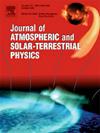Joule Heating rate at high-latitudes by Swarm and ground-based observations compared to MHD simulations
Abstract
We compare Joule Heating rates as derived from ground-based magnetic field and all-sky camera data, from Low Earth Orbit satellite data (ESA Swarm) and from a MHD simulation (GUMICS-5) with each other in a case study of an auroral arc system. The observational estimates of Joule Heating rates provide information on regional scales and with high spatial resolution (10–100 km). Their comparison with global MHD results is conducted for a quiet time interval of a few minutes, just before a magnetic substorm. Analysis of the ground-based observations yields electric field with dominating North-South component pointing towards the arcs and having maxima values in the range 20–35 V/km. Combining these values with Pedersen conductance estimates from optical data (5–10 S) yields Joule Heating rates in the range 2.5–3.5 mW/m. Swarm electric field measurements are consistent in their direction and intensity with the ground-based estimates. They also show that heating is increased particularly in the region where the conductance is low. The total amount of Joule heating in the area between the Swarm A and C satellite footprints while crossing the all-sky camera field of view is estimated to be 46 MW and the total amount energy dissipation during the 80 s overflight is around 3.6 GJ (1000 kWh). GUMICS-5 estimate of the peak Joule Heating in the magnetic local time sector of the arc system is smaller than that from the ground-based data with a factor of 2.9. Comparisons of GUMICS-5 results with Space Weather Modeling Framework (SWMF), shows that the latter gives on average larger heating rates being thus more consistent with our regional observations. However, both MHD-codes yield smaller Joule Heating rates around the time of the arcs and during the following substorm than the CTIP-e code. CTIP-e has a more detailed description of ionosphere-thermosphere interactions than the MHD-codes and its convection electric field is enhanced with a randomly varying additional component mimicking small scale structures. GUMICS-SWMF comparisons of global Joule Heating patterns in the Northern polar area reveal that the two simulations have significant differences in their spatial distribution of heating rates. Main cause for these deviations is the difference in the derivation of ionospheric Pedersen conductance. Our results emphasize the fact that future estimates of the global energetics in the magnetosphere–ionosphere–thermosphere system require better knowledge on ionospheric conductivities, both by new measurement concepts and by better understanding on the background physics controlling conductivity variations.

 求助内容:
求助内容: 应助结果提醒方式:
应助结果提醒方式:


